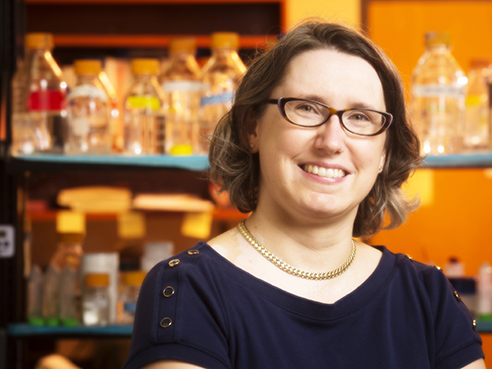 Nicole Riddle, Ph.D., assistant professor of biologyThe NSF CAREER Awards support the early career-development activities of professors who most effectively integrate research and education within the context of the mission of their organization. At UAB, those faculty include Amber Genau, Ph.D., assistant professor of materials science and engineering, and Nicole Riddle, Ph.D., assistant professor of biology.
Nicole Riddle, Ph.D., assistant professor of biologyThe NSF CAREER Awards support the early career-development activities of professors who most effectively integrate research and education within the context of the mission of their organization. At UAB, those faculty include Amber Genau, Ph.D., assistant professor of materials science and engineering, and Nicole Riddle, Ph.D., assistant professor of biology.Riddle’s research project focuses on the Heterochromatin Protein 1 (HP1) family. DNA is packaged into a complex structure that contains a variety of proteins, including those of the HP1 family. As part of a process called gene regulation, these chromatin proteins determine if information stored in a certain portion of the DNA is accessible — the genes are “turned on” — or inaccessible — the genes are “turned off.” Her research addresses how HP1 proteins work together to contribute to gene regulation. Riddle will use her $1.15-million award to fund this research.
| Free training offered for faculty preparing an NSF CAREER award Two sessions will be held — March 24 and April 21 — in Heritage Hall Room 500. RSVP by March 15 to bbeverly@uab.edu. |
Q: What was your reaction to being selected for this honor by the NSF?
Getting the phone call from my program officer with the news was amazing. I felt — and still feel — honored that the scientists that reviewed my grant proposal appreciated the scientific value of my research and judged the effort I had put into integrating my scientific research with my teaching and outreach activities as worthy of support.
Q: What is the hypothesis of your research?
My lab’s research centers on a group of conserved proteins, the HP1 family, that contribute to the regulation of gene expression and DNA packaging. Most organisms have more than one HP1 protein — humans and mice, for example, have three. Our goal is to examine how multiple HP1 proteins interact, because we hypothesize that the different family members cooperate to achieve their diverse functions. Part of the reason why this protein family and their functions is of interest to us is that these proteins are often misregulated in cancers and also in the aging process. Thus, if we understand how these proteins work, we might understand why they are changed in certain diseases and how they contribute to aging. It will help us understand if the change in these proteins is a consequence of the disease/aging, or if they actually help initiate the disease/aging process.
| “Our goal is to examine how multiple HP1 proteins interact, because we hypothesize that the different family members cooperate to achieve their diverse functions.” |
Q: What makes this research unique in the field?
Often, to simplify interpretation of results, only one gene or protein is manipulated. Our approach is to monitor all three HP1 proteins, and to manipulate not only single genes, but also combinations of genes.
Q: What does this award mean for you and your research?
This award is a tremendous help that allows us to move our research forward. We have been able to explore new research avenues, integrate additional students into my research group and establish new collaborations.
I’ve also developed a laboratory course specifically targeted to incoming transfer students coming to UAB from the local community colleges. These students often struggle with the transition to UAB, and they tend to be underrepresented among the students that participate in undergraduate research on campus. The laboratory course I teach as part of my CAREER grant introduces these students to original research, teaches them molecular genetics methods and gets them ready to participate in other undergraduate research, hopefully in their first semester here at UAB.
The students will not only be contributing to the research aspect of the grant, but also gain a peer group for additional support and skills that will help them be matched with a research lab on campus.


